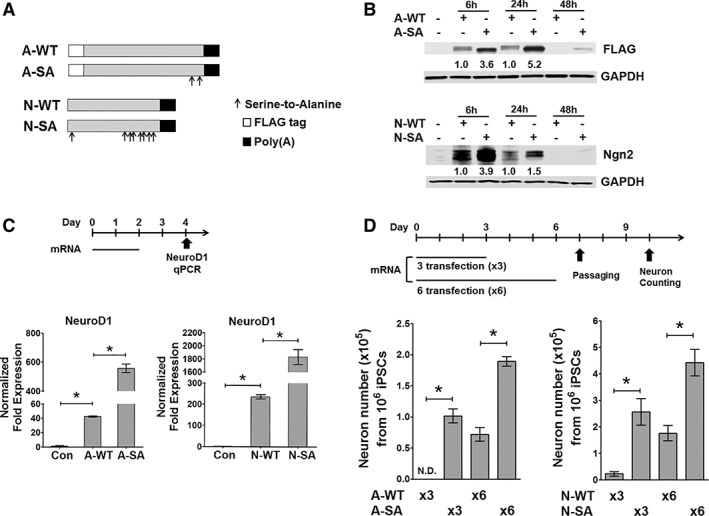Figure 1.

Synthetic mRNAs coding Atoh1 and Ngn2 with phosphosite modification show enhanced protein expression and neuronal induction capability. (A): Diagram of mRNAs coding wild‐type and phosphosite‐modified Atoh1 (A‐WT and A‐SA) and Ngn2 (N‐WT and N‐SA). Arrows: serine‐to‐alanine mutations; Atoh1: at 331 and 342 amino acids; Ngn2: at 24,193, 207, 209, 219, 232, 239, and 242 amino acids. (B): Induced pluripotent stem cells (iPSC1) received a single transfection of mRNAs as indicated, and total proteins were harvested at indicated time points for FLAG (Atoh1) and Ngn2 immunoblotting. Protein fold expression normalized to glyceral‐dehyde‐3‐phosphate dehydrogenase are shown below each lane (A‐WT and N‐WT samples = 1.0). (C): iPSC1 cells received two daily mRNA transfection. Total RNA was isolated for Ngn2 and NeuroD1 quantitative real‐time polymerase chain reaction (qRT‐PCR) at day 2 post transfection (top panel). A‐SA and N‐SA more potently induce their downstream targets than their wild‐type forms (bottom panel, n = 3). (D): iPSC1 cells received three (×3) or six (×6) daily mRNA transfection. Neurons after cell replating were counted at day 10 of differentiation (top panel, n = 6). A‐SA and N‐SA induce more neurons than their wild‐type forms (bottom panel, n = 6). Data represents mean ± SEM; *p < .01.
